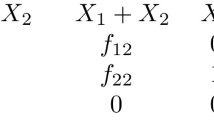Abstract
As an illustration of the potential utility of optimal-control theory, we determine the time-varying electrode potential which maximizes the desired product produced from a coupled, chemical-electrochemical reaction sequence occurring in a well-mixed batch reactor for a specified reaction time. The reactant is electrochemically reduced to a stable intermediate which is itself a reactant for two competing parallel reactions: a homogeneous chemical decomposition to the desired product, or a further electrochemical reduction to an undesired product. If the transfer coefficient of the first reaction is greater than that of the second, then chattering control, in which the potential switches at an infinite frequency between two limits, is optimal. If the transfer coefficients have the opposite relationship, then a continuous, time-varying potential is optimal. We compare the results of applying the optimal, chattering-potential control with those resulting from the best continuous and steady controls. Improved selectivity results from a chattering control and may be effected even in the presence of significant mass-transfer resistance. Since an infinite-frequency control cannot be actually implemented, we discuss how a high-frequency, rectangular waveform can be determined which results in essentially the same product distribution as a chattering control. A qualitative, simple-to-apply method to determine whether selectivity enhancement is attainable using chattering controls is also illustrated.
Similar content being viewed by others
References
G. P. Sakellaropoulous, AIChE J. 25(5) (1979) 781.
G. P. Sakellaropoulous and G. A. Francis, J. Electrochem. Soc. 126 (1979) 1728.
F. J. M. Horn and R. C. Lin, I & EC Proc. Des. Devel. 6 (1967) 21.
F. A. Fine and S. G. Bankoff, I & EC Fundamentals 6 (1967) 293.
L. Padmanabhan and S. G. Bankoff, Automatica 8 (1972) 65.
D. L. Schwieg and T. Z. Fahidy, Int. J. Control 20 (1974) 811.
M. A. Latifi, S. Risson and A. Storck, Entropie 163 (1991) 37.
A. J. Avila and M. J. Brown, Plating 57 (1970) 1105.
H. Y. Cheh, J. Electrochem. Soc. 118 (1971) 551.
D. T. Chin, J. Electrochem. Soc. 130 (1983) 1657.
J. Cl. Puippe and F. Leaman (eds), ‘Theory and Practise of Pulse Plating’, AESF (1986).
T. R. Nolen and P. S. Fedkiw, J. Appl. Electrochem. 20 (1990) 370.
R. Bakshi, Ph.D. Thesis, North Carolina State University, Raleigh, NC (1992).
W. H. Ray, ‘Advanced Process Control’, McGraw Hill, New York (1981).
M. Athans and P. L. Falb, ‘Optimal Control’, McGraw Hill, New York (1966).
M. M. Denn, ‘Optimization by Variational Methods’, McGraw Hill, New York (1969).
Iu. P. Petrov, ‘Variational Methods in Optimal Control Theory’, Academic Press, New York (1968).
S. K. Mitter, Automatica 3 (1967) 135.
C. W. Merriam, Information and Control 8 (1965) 215.
L. S. Pontryagin, ‘The Mathematical Theory of Optimum Processes’, Wiley Interscience, New York (1962).
L. T. Biegler, Comput. & Chem. Eng. 8 (1984) 243.
T. H. Tsang, D. M. Himmelblau and T. F. Edgar, Int. J. Control 21 (5) (1975) 763.
C. P. Neuman and A. Sen, Automatica 9 (1973) 601.
C. P. Neuman and A. Sen, IEEE Trans. Autom. Control. 19 (1974) 67.
M. Minoux, ‘Mathematical Programming’, Wiley-Interscience, New York (1986).
J. C. Dunn, Control Dyn. Syst. 29 (2) (1988) 135.
D. G. Luenberger, ‘Optimization by Vector Space Methods’, John Wiley, New York (1969).
L. Hasdorff, ‘Gradient Optimization and Nonlinear Control’, John Wiley, New York (1976).
L. Armijo, Pac. J. Math. 16 (1966) 1.
V. F. Demyanov and A. M. Rubinov, ‘Approximate Methods in Optimization Problems’, American Elsevier, New York (1970).
D. Bertsekas, IEEE Trans. Autom. Control 21 (1976) 174.
J. Warga, J. Math. Anal. Appl. 4 (1962) 11.
M. Fjeld, Chem. Eng. Sci. 29 (1974) 921.
R. V. Gamkrelidze, ‘Principles of Optimal Control Theory’, Plenum Press, New York (1978).
J. C. Smeltzer and P. S. Fedkiw, J. Electrochem. Soc. 139 (1992) 1358.
R. T. Rockafellar, ‘Convex Analysis’, Princeton University Press, Princeton, NJ (1970).
R. Bakshi and P. S. Fedkiw, ‘The Optimal Time-Varying Cell-Voltage Control for a Parallel-Plate Reactor’, under review (1993).
J. C. Puippe and N. Ibl, J. Appl. Electrochem. 10 (1980) 775.
F. J. M. Horn and J. E. Bailey, J. Optimization Theory Appl. 2 (1968) 441.
P. S. Fedkiw and W. D. Scott, J. Electrochem. Soc. 131 (1984) 1304.
Author information
Authors and Affiliations
Rights and permissions
About this article
Cite this article
Bakshi, R., Fedkiw, P.S. Optimal time-varying potential control. J Appl Electrochem 23, 715–727 (1993). https://doi.org/10.1007/BF00243341
Received:
Revised:
Issue Date:
DOI: https://doi.org/10.1007/BF00243341




